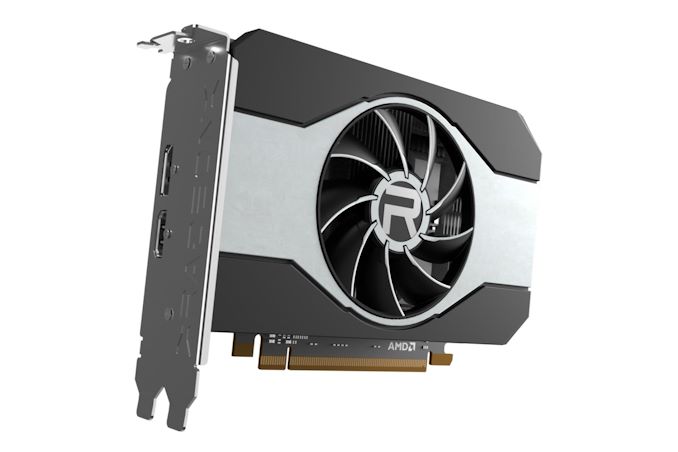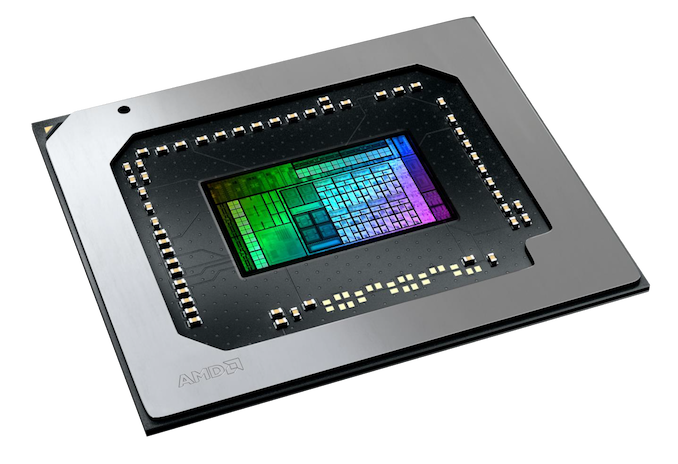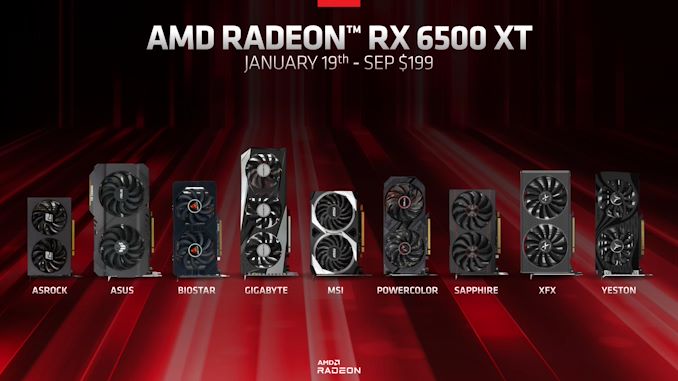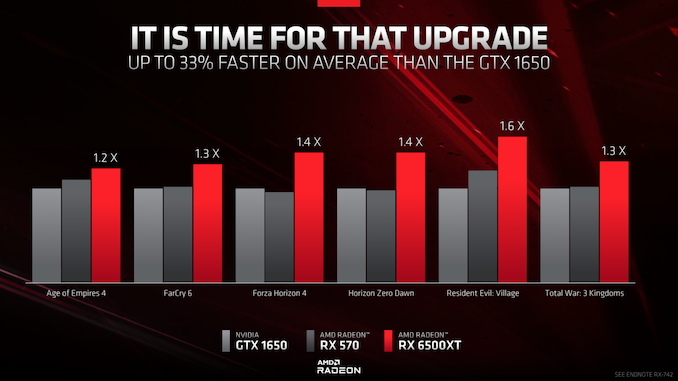Launching Today: AMD's Radeon RX 6500 XT, Starring Navi 24
by Ryan Smith on January 19, 2022 9:31 AM EST
Following its announcement back at CES, today AMD is formally launching the entry-level member of its Radeon RX 6000 series of video cards: the Radeon RX 6500 XT. Based on AMD’s new Navi 24 GPU – the first GPU made on TSMC’s N6 process – AMD is broadening their desktop video card lineup by adding a new low-end option. And while the $199 price tag is unlikely to arouse much enthusiasm, the addition of another video card SKU – and one that’s relatively useless for crypto mining – is likely to be a welcome relief for the capacity-constrained discrete video card market.
Diving right in, the big hardware development driving the new desktop cards is the introduction of AMD’s new Navi 24 GPU. The fourth and seemingly final member of AMD’s Navi 2x GPU stack, Navi 24 is aimed at the low-end/entry-level segment of the market. The smallest of the Navi GPUs has seen AMD once again take a scalpel to the Navi 2x architecture, essentially cutting Navi 23 in half to deliver a part with half of the CUs, half the Infinity Cache, and roughly half of the power consumption.
And it’s not just the number of CUs that have been cut down; AMD has stripped down the Navi 2x design just about as far as it can go. Navi 24 offers just 2 display controllers, for example. And a PCIe 4.0 x4 bus. Meanwhile the Infinity Cache is just 16MB – though even at that size, the Infinity Cache is still 15% of AMD’s transistor budget. And even the video encode/decode blocks have been scaled down, with AMD taking out the encode block and removing AV1 from the decode block. The net result is that AMD is able to get a Navi 2x design down to 5.4B transistors, fewer transistors than its predecessor, Navi 14, or even the last-generation Polaris 10.
But as an added kicker, AMD isn’t reusing TSMC’s 7nm process for Navi 24. Instead, the smallest of the Navi chips is being made on TSMC’s N6 line. This marks the second AMD GPU/accelerator we’ve seen made on 6nm – after the gigantic CDNA2 chip in the Radeon Instinct MI250X – so AMD is taking full advantage of their close working relationship with TSMC, and in turn taking advantage of the benefits offered by what’s essentially a further refined version of TSMC’s 7nm process. Based on what we know about N6, the switch to it likely isn’t adding much in the way of performance for AMD, but the roughly 15% improvement in transistor density will enable AMD to get that many more dies out of every wafer at a time when fab capacity is at a premium.
All of which makes Navi 24 a very small chip, measuring in at 107mm2. That’s less than half the size of Navi 23 (237mm2) or even Navi 14 (158mm2). Which, not to get hung up on die sizes here, but it’s important to underscore just how small Navi 24 is at a time when high-end PC GPUs are in the 500-700mm2 range. AMD hasn’t made a GPU this small in almost half a decade, when they released the RX 550 and other parts based on Polaris 12 (101mm2). To put it bluntly, Navi 24 is meant to be AMD’s ultimate play in offering an entry-level, high-volume GPU for the PC market, and they haven’t been afraid to make some bigger feature sacrifices to get there.
Meanwhile, expect to see Navi 24 all over the place. Along with today’s Radeon RX 6500 XT launch, there’s also the launch of the Radeon Pro W6400. And OEMs can look forward to the Radeon RX 6400 landing some time in the first half of this year. Finally, Navi 24 will also be making a mobile appearance as the Radeon RX 6500M and RX 6300M. Given its small die size, high manufacturability, and traditional market dynamics around price, expect to see a lot of Navi 24-powered products over the coming months.
| AMD Radeon RX Series Specification Comparison | ||||||
| AMD Radeon RX 6600 | AMD Radeon RX 6500 XT | AMD Radeon RX 6400 | AMD Radeon RX 5500 XT | |||
| Stream Processors | 1792 (28 CUs) |
1024 (16 CUs) |
768 (12 CUs) |
1408 (22 CUs) |
||
| ROPs | 64 | 32 | 32 | 32 | ||
| Game Clock | 2044MHz | 2610MHz | 2039MHz | 1717MHz | ||
| Boost Clock | 2491MHz | 2815MHz | 2321MHz | 1845MHz | ||
| Throughput (FP32) | 7.3 TFLOPS | 5.3 TFLOPS | 3.1 TFLOPS | 5.2 TFLOPS | ||
| Memory Clock | 14 Gbps GDDR6 | 18 Gbps GDDR6 | 16 Gbps GDDR6 | 14 Gbps GDDR6 | ||
| Memory Bus Width | 128-bit | 64-bit | 64-bit | 128-bit | ||
| VRAM | 8GB | 4GB | 4GB | 8GB | ||
| Infinity Cache | 32MB | 16MB | 16MB | N/A | ||
| Total Board Power | 132W | 107W | 53W | 130W | ||
| Manufacturing Process | TSMC 7nm | TSMC N6 | TSMC N6 | TSMC 7nm | ||
| Transistor Count | 11.06B | 5.4B | 5.4B | 6.4B | ||
| Architecture | RDNA2 | RDNA2 | RDNA2 | RDNA (1) | ||
| GPU | Navi 23 | Navi 24 | Navi 24 | Navi 14 | ||
| Launch Date | 10/13/2021 | 01/19/2022 | H1 2022 | 12/12/2019 | ||
| Launch Price | $329 | $199 | OEM-Only | $199 | ||
Diving into the RX 6500 XT itself, at a high level what we’re looking at is close to being half of a Radeon RX 6600 XT. The biggest shift, of course, is halving the number of CUs to 16, which brings for a total of 1024 SPs. Navi 24 is designed to be a small part and that much is reflected in the amount of hardware at hand. Offsetting part of that, however, is that the advertised game clock is a very peppy 2.6GHz, which is a couple of hundred MHz higher than even the 6600 XT. As a result, the 6500 XT punches a bit harder than we’d otherwise expect for a 16 CU part.
As for memory configurations, the RX 6500 XT gets a 64-bit memory bus. This is in line with halving the other resources on the card, as well as consistent with AMD’s design goals to use smaller memory busses on Navi 2x parts than their Navi 1x predecessors. That means that for the 6500 XT we’re looking at 144GB/second of external memory bandwidth, a bit more than we’d otherwise get courtesy of AMD’s decision to use the latest generation of 18Gbps GDDR6 here. This faster VRAM is just starting to hit new video cards, and for parts like the 6500 XT with very narrow memory busses, its virtues should be especially beneficial.
Meanwhile, as previously mentioned, the Infinity Cache has been cut down to just 16MB. So the RX 6500 XT is in the interesting position of trying to make the most of its small-but-fast Infinity Cache before a big jump in latency when going off-die. Interestingly, the Infinity Cache itself has been cut down by so much at this point that its effective bandwidth is also quite low; based on AMD’s “combined” figures, the Icache bandwidth is only 87.6GB/second, which is only about 60% of the VRAM bandwidth. So unlike AMD’s higher-end parts, where the Icache bandwidth significantly outpaces the VRAM bandwidth, that’s not the case here. And that means the benefits of the Infinity Cache are more about latency than raw bandwidth.
Unfortunately, this has also served as an impetus for AMD to advertise the 6500 XT based on an “effective memory bandwidth” figure by adding up the Infinity Cache and VRAM bandwidth. Which for the RX 6500 XT is 231.6GB/second (144GB/sec VRAM + 87.6GB/sec Icache). While I won’t dwell on this point too much, this is a ridiculous metric. On no other processor will you find the L3 cache bandwidth be added to the DRAM bandwidth – even in designs where the L3 cache is exclusive of the DRAM. The presence of the Infinity Cache does change how buyers need to think about the relationship between VRAM bandwidth and performance, but adding in the bandwidth of a tiny local cache that’s 1/256th the size of the VRAM pool is not the right way to go about it.
Moving on, as a side benefit of stripping down Navi 2x and jumping to N6 is that power consumption has also gone down. On the mobile side this makes for 35W parts, and even on the desktop side we’re looking at power figures that AMD hasn’t been able to match since the Polaris days. With a 107W TBP for standard cards (and 120W for factory overclocked cards), the RX 6500 XT is a decent clip lower than AMD’s other retail RX 6000 series cards. However HTPC builders are going to come away a bit disappointed, as the 107W TBP is much too high for a bus-powered card. The Radeon RX 6400 will be under 75W, at just 53W, but that part will be OEM-only.
Partner Cards, Product Positioning, & Availability
Bringing RX 6500 XT to market, in turn, will be AMD’s regular stable of add in board (AIB) partners. Today’s launch is a pure virtual launch – AMD won’t be supplying a reference card for retail sales – so the AIBs get all of the glory for themselves.
Expect these cards to run the full gamut in terms of designs and features. Based on the product shots supplied by AMD, we’ve already seen everything from single-fan cards to massive triple-fan designs. Similarly, expect a lot of factory overclocked SKUs, owing to the relatively low power of the base 6500 XT specification and the fact that AIBs like to use factory overclocks as a value add feature. Retail prices for AIB cards will start at $199, with higher-end offerings going for more than that. And ultimately, retail prices will be at the whim of the larger retail market.
On that note, it goes without saying that as far as product positioning goes, where the Radeon RX 6500 XT fits in to the bigger picture is a constantly shifting situation. The ongoing GPU shortage means that all logic has long since flown the coop – and isn’t coming back any time soon. So at best, we can talk about where AMD intends for it to compete, and then we’ll see where the market takes it over the coming weeks and months.
For the next week at least, AMD has the run of the place. NVIDIA will be launching the GA106-based GeForce RTX 3050 in just over a week’s time. But since that’s based on salvaged GA106 dies (and not the smaller GA107s used in RTX 3050 for Laptops), it’s not at all clear how supply will compare. Furthermore NVIDIA is positioning RTX 3050 as a higher performing/higher priced product – the MSRP is $249 versus $199 for the RX 6500 XT – so they may not end up particularly close to each other.
Since AMD is the first out of the gate, AMD’s own performance numbers are comparing the low-end card to what they can: products like the GeForce GTX 1650 and the generations-old Radeon RX 570 4GB, which has fallen out of favor with cryptocurrency miners due to its small memory capacity. In both those cases the RX 6500 XT should be a faster card, according to AMD.
The RX 570 is actually a more interesting comparison than it initially lets on to, both due to transistor count and market positioning. Despite having around 300 million (~5%) fewer transistors than the Polaris 10/20 GPU used there, RX 6500 XT is the faster product – and this is with the additional transistor overhead of two generations of newer graphics engine features, such as ray tracing, mesh shaders, and conservative rasterization. Of course, this is counted by things AMD has taken out or cut back upon, such as video encode, display controllers, and memory controller blocks. Still, it goes to underscore where and how AMD has streamlined things for their smallest GPU.
Still, based on AMD’s own choice in games, it’s not a generation ahead of either card. The RX 6500 XT is a low-end video card; the only cards it’s going to come close to doubling the performance of are similar low-end cards from 5 years ago. Cards which never sold at $199 to begin with.
The relatively good news is that the 6500 XT should make a terrible mining card due to both its limited memory capacity and equally limited memory bandwidth, so there shouldn’t be a lot of demand from miners for the card. However, that will be tempered by the fact that gamers and other desktop computer builders, also facing the ongoing shortage for video cards, can and have been scooping up even low-end video cards in order to get their hands on something and to complete system builds. So there’s a very good chance that gamer/consumer demand alone is enough to soak up whatever AMD can produce; it’s something that will be worth keeping an eye on.
The base MSRP of $199, in turn, is not unreasonable given current market conditions. But the 6500 XT is certainly not going to be a deal by any stretch of the word. Take your pick: cryptocurrency mining, inflation, escalating fab costs – while the RX 6500 XT should improve the overall video card supply, it’s not going to do any favors in terms of pricing. In that respect we’re still a long way from normal in the video card market.
In any case, it’s certainly a very unique way to kick off the first video card launch of the year. And with NVIDIA’s GeForce RTX 3050 scheduled for next week, we aren’t done with low-end video cards yet. The PC market is desperate for discrete video cards of any kind, and with the high manufacturing volumes afforded by low-end cards, with any luck there should be some more flexibility and market availability going into 2022.
| Q1 2022 GPU Product Lineups (Theoretical MSRPs, Please See eBay For Street Pricing) |
|||||
| AMD | Price | NVIDIA | |||
| N/A | GeForce RTX 3090 Ti | ||||
| $1499 | GeForce RTX 3090 | ||||
| $1199 | GeForce RTX 3080 Ti | ||||
| N/A | GeForce RTX 3080 12GB | ||||
| Radeon RX 6900 XT | $999 | ||||
| Radeon RX 6800 XT | $649/$699 | GeForce RTX 3080 | |||
| Radeon RX 6800 | $579/$599 | GeForce RTX 3070 Ti | |||
| Radeon RX 6700 XT | $479/$499 | GeForce RTX 3070 | |||
| Radeon RX 6600 XT | $379/$399 | GeForce RTX 3060 Ti | |||
| Radeon RX 6600 | $329 | GeForce RTX 3060 | |||
| $249 | GeForce RTX 3050 | ||||
| Radeon RX 6500 XT | $199 | ||||



















101 Comments
View All Comments
shabby - Wednesday, January 19, 2022 - link
Rip gpu reviews @ AnandTech 1997-2019, you'll be missed!velanapontinha - Wednesday, January 19, 2022 - link
amenKurosaki - Wednesday, January 19, 2022 - link
Anyone know what happened? This was my to go to site for GPU data. Makes me sad.Unashamed_unoriginal_username_x86 - Wednesday, January 19, 2022 - link
From what I recall hearing from Ryan they stopped getting sampled. He was also effected by Cali wildfiresKurosaki - Wednesday, January 19, 2022 - link
But, stopped getting sampled? They were the best techsite in the world. How could it be?WJMazepas - Wednesday, January 19, 2022 - link
Probably AMD and Nvidia are focusing on the youtubers reviewersKurosaki - Wednesday, January 19, 2022 - link
But still, a site of this caliber. I. Just. Don't get it. Their database is still my to go to for comparing new cards with the on older ones. Sad, hope Anandtech gets it together, else I'm afraid it will just disperse in timeSamus - Friday, January 21, 2022 - link
Seriously, fuck nVidia and AMD if that is true. AMD and Intel will give them engineering samples of CPU's and a confidentiality launch date, but they won't supply them RETAIL products for review over Youtubers? I don't want to see some dude play games comparing cards with the FPS in the corner. I want charts.at_clucks - Friday, January 21, 2022 - link
"Youtubers" also covers Gamers Nexus: https://www.youtube.com/watch?v=ZFpuJqx9QmwBut there are plenty of reviewers who found a way to review this card:
https://www.tomshardware.com/reviews/amd-radeon-rx...
https://www.pcgamer.com/amd-radeon-rx-6500-xt-revi...
https://www.techspot.com/review/2398-amd-radeon-65...
mode_13h - Wednesday, January 19, 2022 - link
Maybe if you stop reviewing the cards they *do* send, they catch on and stop sending you cards. Just a guess.